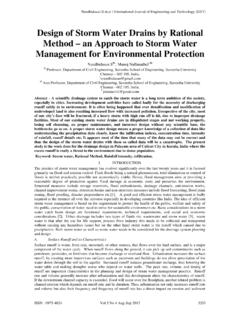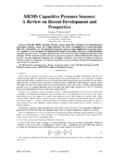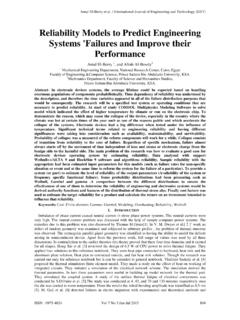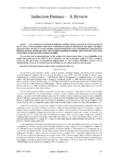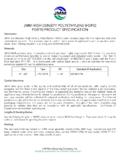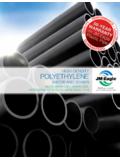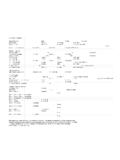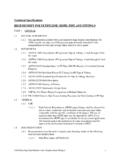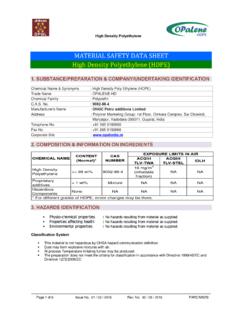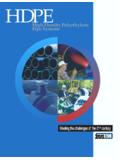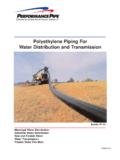Transcription of Properties of Oil Palm Empty Fruit Bunch Fibre Filled High ...
1 Chinomso M. Ewulonu et al. / International Journal of Engineering and Technology (6), 2011-2012, 458- 471. Properties of Oil Palm Empty Fruit Bunch Fibre Filled high density polyethylene Chinomso M. Ewulonu#1, and Isaac O. Igwe*2. #. Department of Polymer & Textile Engineering, Nnamdi Azikiwe University 5025, Awka, Nigeria 1. *. Department of Polymer & Textile Engineering, Federal University of Technology, P. M. B. 1526, Owerri, Nigeria 2. Abstract The Properties of oil palm Empty Fruit Bunch (OPEFB) Fibre Filled high density polyethylene (HDPE) have been investigated at filler loadings, 0 to wt. %. Maleic anhydride g polyethylene (MAPE) was used as a compactibilizer.
2 Oil palm Empty Fruit Bunch Fibre was prepared at three particle sizes namely, , , and mm. The HDPE composites were prepared in an injection moulded machine. Results showed that for any given particle size of OPEFB Fibre considered, the tensile strength and elongation at break of the HDPE composites decreased with increase in OPEFB loadings. However, the addition of MAPE was found to improve these Properties . The hardness, and specific gravity of the composites were found to increase with increase in filler loadings and were further increased on addition of MAPE. The water sorption indices (24-h cold water and 2-h hot water) of the composites also increased with increase in OPEFB loadings, and particle sizes, but were decreased on addition of MAPE.
3 OPEFB. Fibre was inefficient in reducing the flame propagation rate of HDPE; the incorporation of MAPE into the systems reduced the propagation rate of the composites. Keywords high density polyethylene , maleic anhydride graft polyethylene , oil palm Empty Fruit Bunch Fibre , mechanical and end-use Properties I. INTRODUCTION. Polymers, such as polyethylene , have found many applications in our modern world. These polymers are frequently compounded with natural minerals so as to improve their Properties . For example, glass Fibre is used to improve the stiffness and strength of thermoplastics [1]. However, glass fibres and mineral fillers require a lot of energy to process since processing temperatures can exceed 1200 oC.
4 These fillers also tend to abrade processing equipments and increase the density of the thermoplastic system. Similarly, the growing global environmental concern, the high rate of depletion of petroleum and mineral resources, as well as new environmental regulations have forced the search for new Fibre reinforced composite materials that are compatible with the environment. Oil palm Empty Fruit Bunch (OPEFB) fibres are natural fibres and represent an environmentally friendly alternative to conventional reinforcing fibres. These fibres are available in abundance, renewable, nontoxic, and their low cost are of industrial economic interest.
5 The main limitation to the use of natural fibres in reinforcing polymers is the lower processing temperature permissible due to the possibility of Fibre degradation and/or the possibility of volatile emissions that could affect composite Properties , thus limiting the processing of natural fiber components to about 200 C. [2]. Other drawbacks include the high moisture absorption of natural fibres, poor wetability, and general incompatibility with some polymeric matrices. polyethylene is the most frequently used thermoplastic for the production of natural fiber plastic composites. This is due to its lower melting point, general availability, and low cost.
6 [3]. Despite the limitations on the use of natural fibers in producing polymer composites, the use of these fibres in composite making is gaining importance nowadays and a number of research works are published in the scientific literature. Najafi et al [4] prepared composites of different lignocellulosic materials and high density polyethylene at 25 and 50 wt. % Fibre , and 1 and 2 % compatibilizer contents respectively. Water absorption tests carried out on injection-moulded specimens at room temperature for five weeks showed that kenaf and newsprint fibres exhibited higher water absorption values, while wood flour and rice hulls showed the ISSN : 0975-4024 Dec 2011- Jan 2012 458.
7 Chinomso M. Ewulonu et al. / International Journal of Engineering and Technology (6), 2011-2012, 458- 471. least. Najafi et al [5] prepared composites of sawdust, virgin and/or recycled high density polyethylene (HDPE). The flexural, tensile Properties and impact strength of the prepared composites were determined by standard procedures. Results showed that the mechanical Properties of samples containing recycled HDPE were statistically similar and comparable to those of composites made from virgin HDPE. The authors considered this as a possibility to expand the use of recycled plastics in the manufacture of wood plastic composites.
8 Kajaks and Reihmane [6] investigated the thermal, and water sorption Properties of polyethylene and linen yarn production waste composites. The wastes were obtained at different stages of linen yarns production, both virgin and recycled polyethylene were used. It was found that the modification of composites with diphenylmethane diisocyanate gave considerable increase of thermal stability, decreased water sorption, and water diffusion coefficients in composites. Brahmakumar et al [7] studied the use of coconut Fibre in making low density polyethylene composites. The effect of natural waxy surface layer of the Fibre on Fibre /matrix interfacial bonding and composite Properties were studied by single Fibre pullout test.
9 The tensile Properties of oriented, discontinuous Fibre composites were determined. It was found that the waxy layer provided good fiber matrix bond such that removal of the layer resulted in drastic decrease of the pullout stress, increase of the critical Fibre length, and corresponding decrease in tensile strength and modulus of the composites. Rozman et al [8] studied the mechanical Properties of high density polyethylene (HDPE) oil palm Empty Fruit Bunch (EFB) composites using three different particle sizes of EFB and at different filler loadings. The modulus of elasticity (MOE) and modulus of rupture (MOR) of the EFB HDPE composites were found to increase, and decrease respectively with increase in filler loading.
10 It was found that samples with smaller sized particles displayed higher MOE and MOR when compared to the larger sized particles. The flexural, tensile, and impact strengths of the composites were found to decrease with increase in the amount of filler incorporated. The oil palm Empty Fruit Bunch (EFB) polyethylene composites produced using an internal mixer was investigated by Rozman et al [9]. It was reported that the incorporation of EFB into the polymer matrix resulted in the reduction of flexural strength. Both the flexural and tensile modulus of the prepared composites were found to be improved upon addition of EFB. The water absorption and thickness swelling of the composites were found to increase on the incorporation of EFB as filler.
